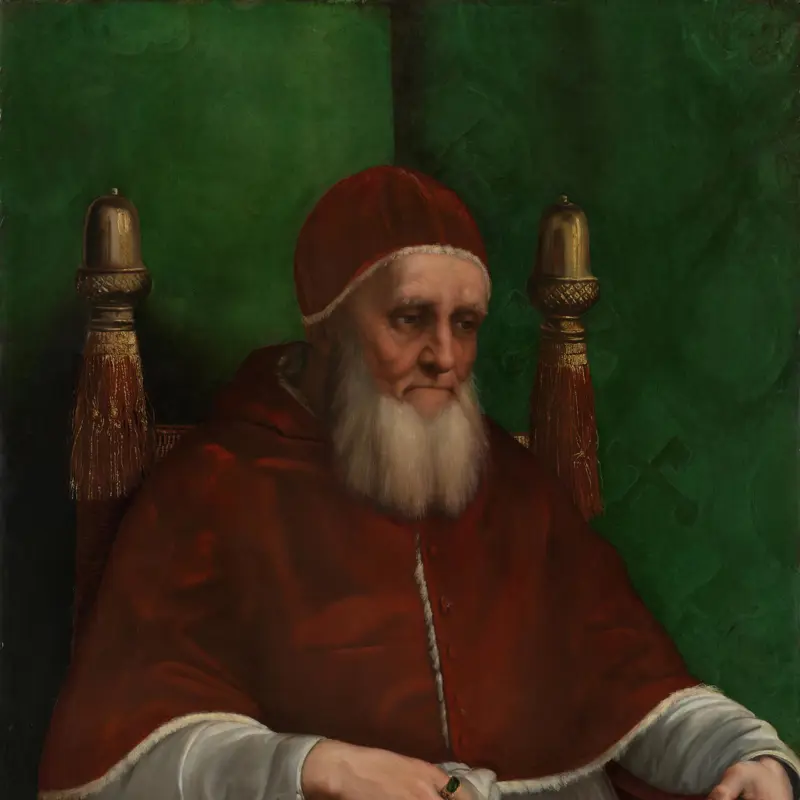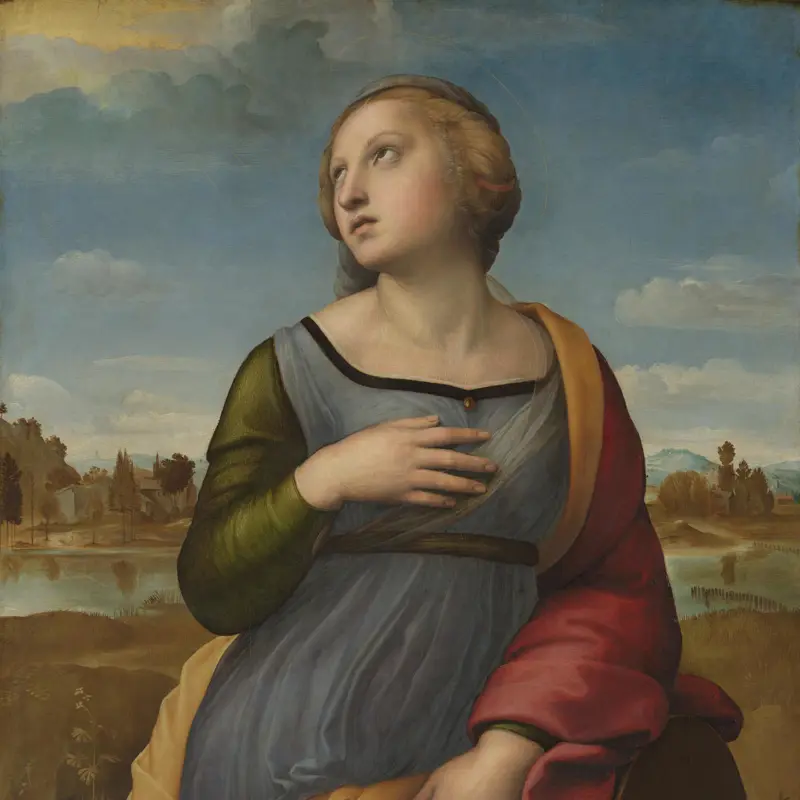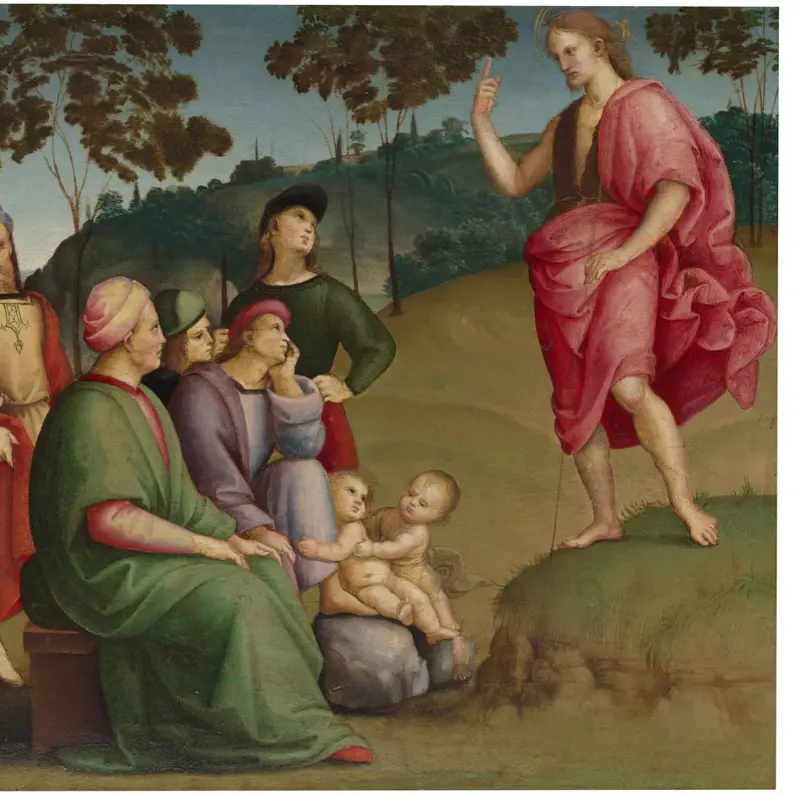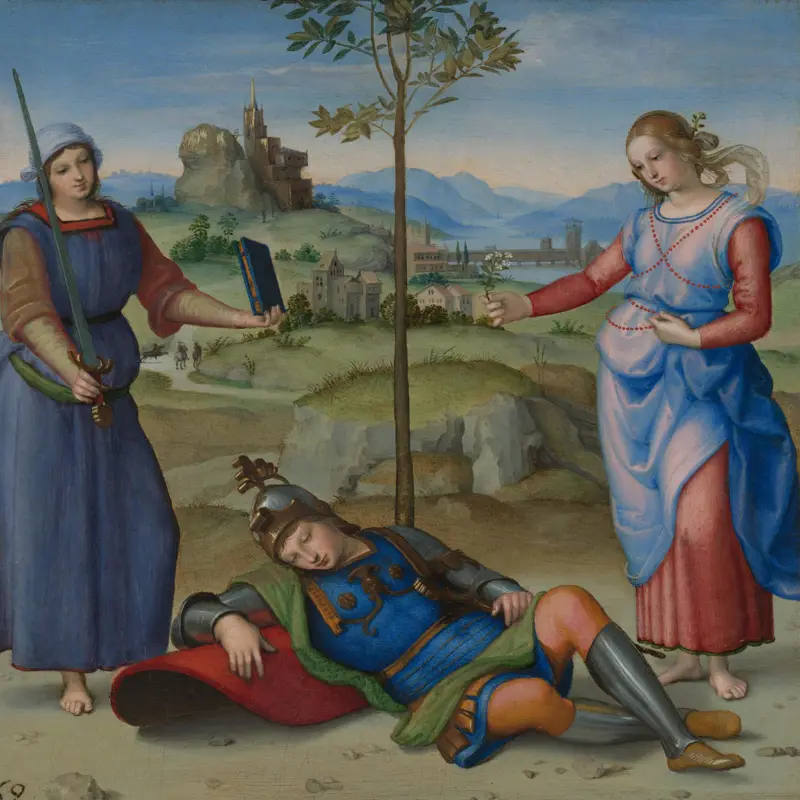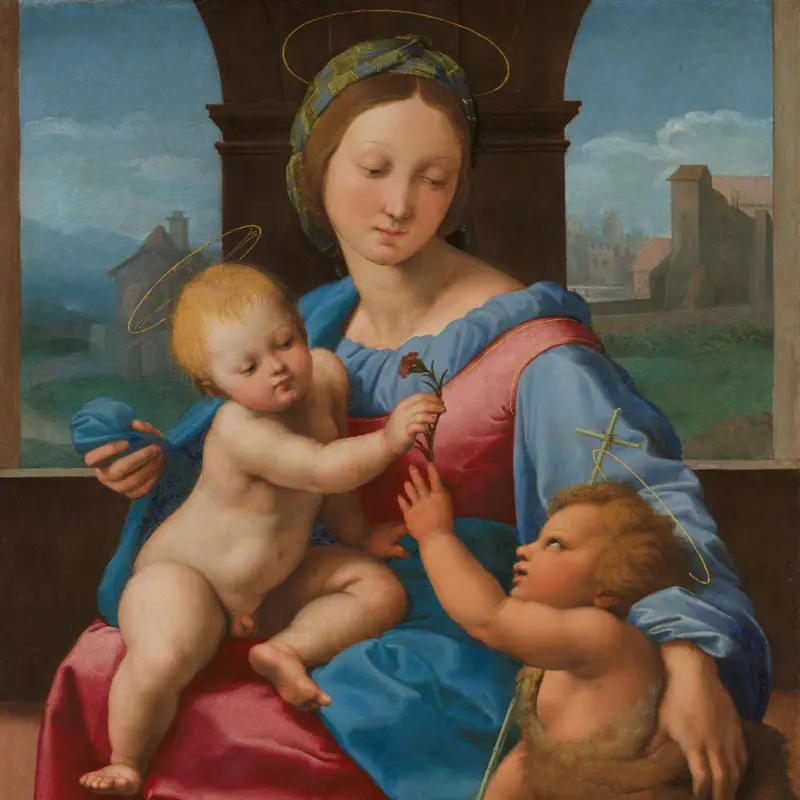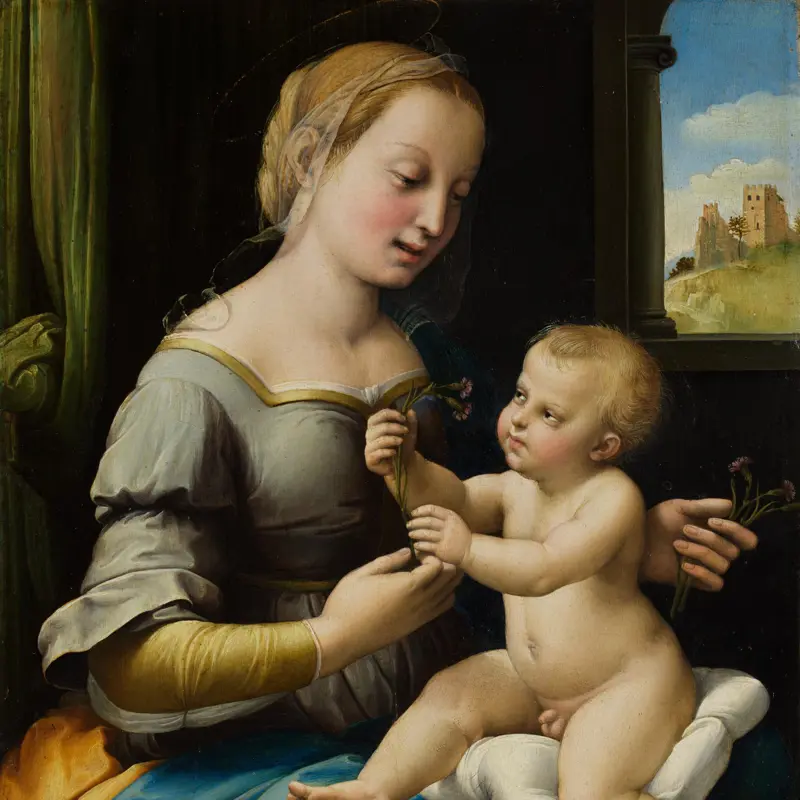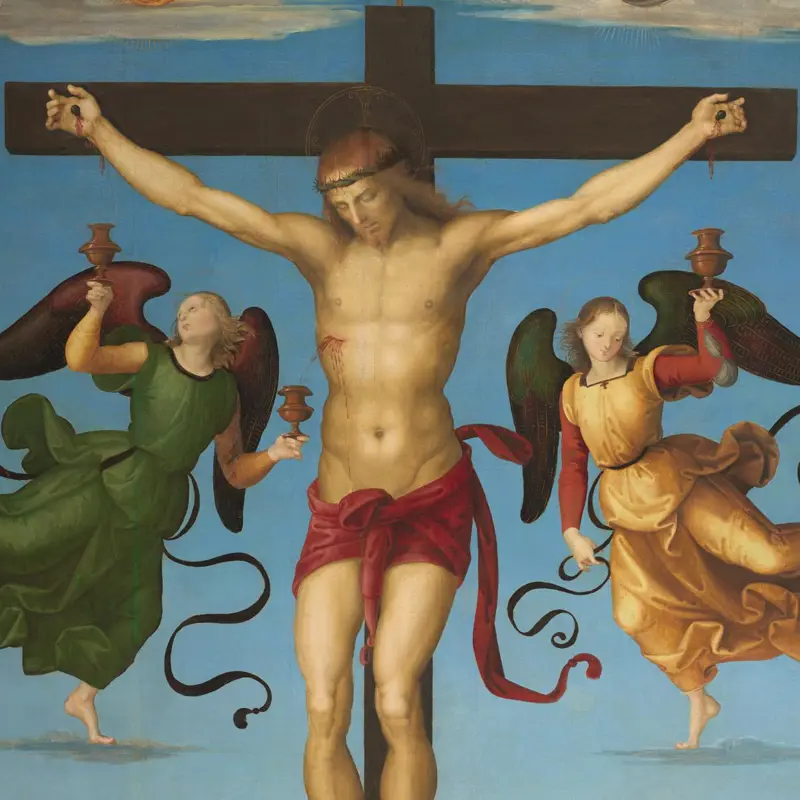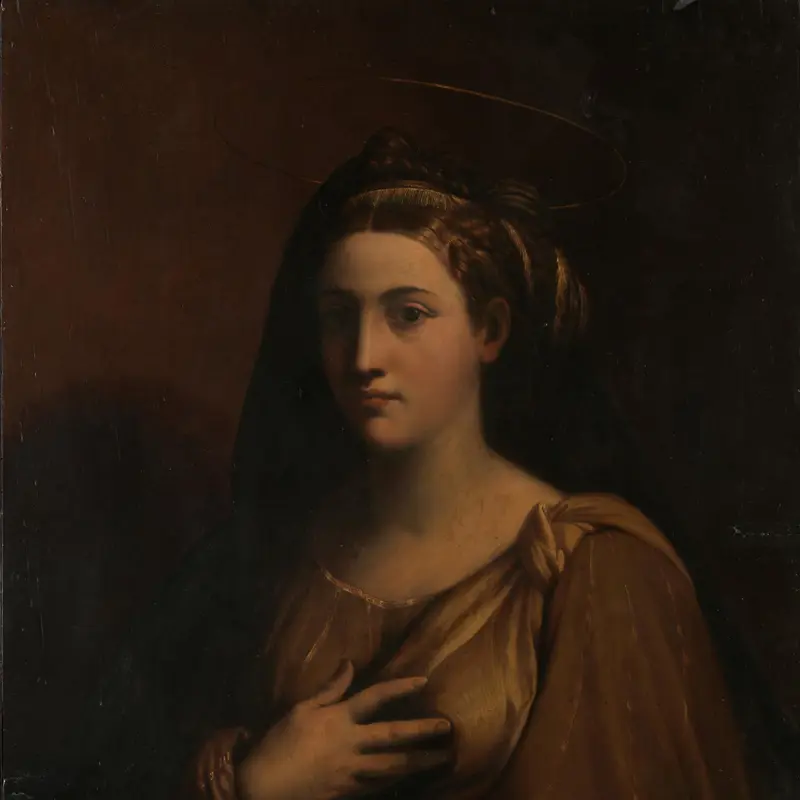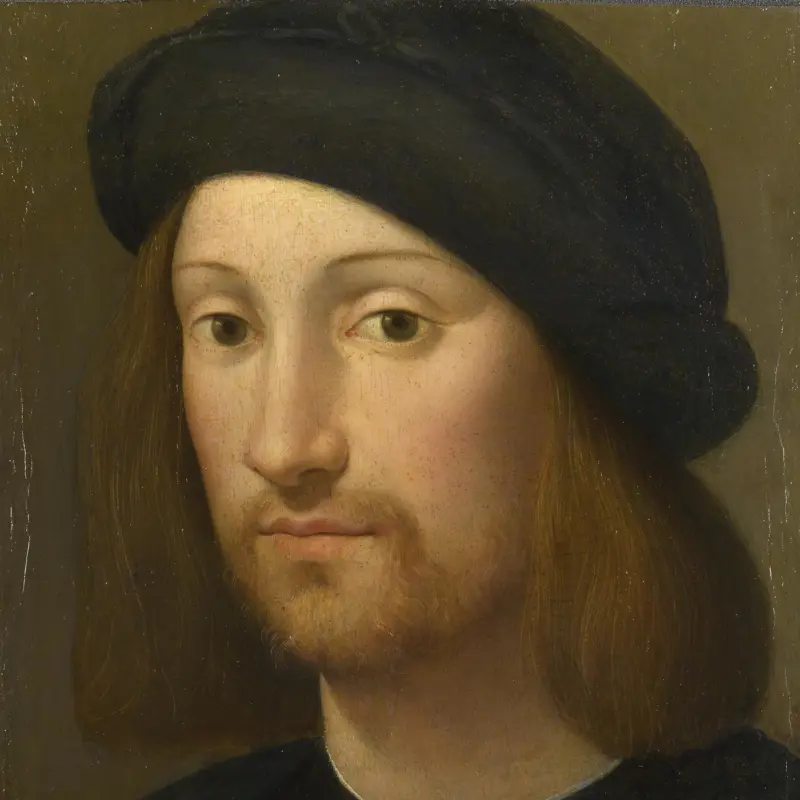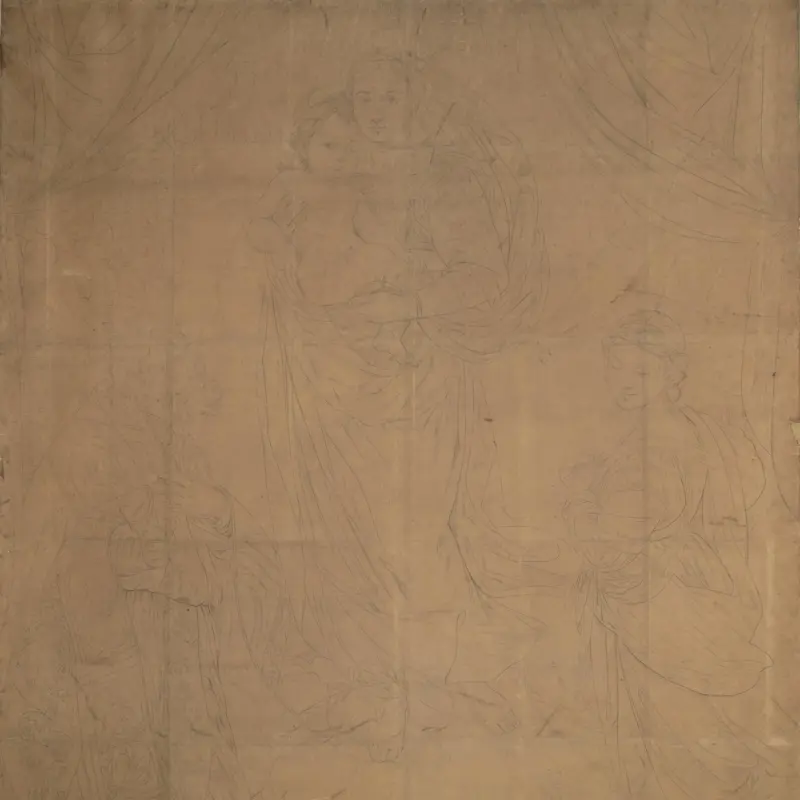Raphael, 'The Madonna and Child (The Mackintosh Madonna)', about 1509-11
About the work
Overview
The infant Christ throws his arms affectionately around his mother’s neck and smiles at us. But the Virgin Mary’s eyes are downcast, as though her thoughts are already on his future sacrifice.
The painting probably dates from the early years of Raphael’s time in Rome. It is called the ‘Mackintosh Madonna’ after the person who donated it to the National Gallery. It is also known as the ‘Madonna of the Tower’ because of the building just visible in the left background.
The picture is so damaged that it gives little idea of how it looked originally. The full-size template drawing, or cartoon, for it (British Museum, London) reveals soft atmospheric lighting and a psychological depth that has been lost in the painting, suggesting why this was one of Raphael’s compositions that appealed most powerfully to later artists.
Domenico Alfani, who had collaborated with Raphael, probably used the cartoon as the basis for an altarpiece dated 1518 (Perugia, Galleria Nazionale).
Key facts
Details
- Full title
- The Madonna and Child (The Mackintosh Madonna)
- Artist
- Raphael
- Artist dates
- 1483 - 1520
- Date made
- About 1509-11
- Medium and support
- Oil, originally on wood, transferred to canvas
- Dimensions
- 78.8 × 64.2 cm
- Acquisition credit
- Presented by Mrs Eva Mackintosh, 1906
- Inventory number
- NG2069
- Location
- Not on display
- Collection
- Main Collection
- Previous owners
- Frame
- 19th-century English Frame
Provenance
Additional information
Text extracted from the ‘Provenance’ section of the catalogue entry in Carol Plazzotta and Tom Henry, ‘National Gallery Catalogues: The Sixteenth Century Italian Paintings’, vol. 4, ‘Raphael’, London 2022; for further information, see the full catalogue entry.
Exhibition history
-
2008Faith and Love: Picturing the Bible From Raphael To El GrecoThe Bowes Museum11 October 2008 - 4 January 2009
-
2019Raphael and the friends of UrbinoGalleria Nazionale delle Marche3 October 2019 - 19 January 2020
Bibliography
-
1727L.D. de Saint-Gelais, Description des tableaux du Palais Royal: Avec la vie des peintres à la tête de leurs ouvrages: Dédiée à Monseigneur le duc d'Orleans, premier prince du sang, Paris 1727
-
1729J.A. Crozat, Recueil d'estampes d'après les plus beaux tableaux et d'après les plus beaux desseins qui sont en France, dans le Cabinet du roy, dans celuy de Monseigneur le duc d'Orléans et dans d'autres cabinets, 2 vols, Paris 1729
-
1786J. Couché, Galerie du Palais-Royal gravée d'après les tableaux des différentes écoles qui la composent, avec un abrégé de la vie des peintres et une description historique de chaque tableau, Paris 1786
-
1798Michael Bryan's Gallery, A Catalogue of the Orléans' Italian Pictures which will be Exhibited for Sale by Private Contract on Wednesday 26th December 1798 and Following Days at the Lyceum in the Strand and at Mr. Bryan's Gallery, 88 Pall Mall, London, 26 December 1798
-
1800Peter Coxe, Burrell, and Foster, Orleans Sale, 1800, London, 14 February 1800
-
1816Christie's London, A Catalogue of the Highly Distinguished and Very Celebrated Collection of Italian, French, Flemish and Dutch Pictures: The Genuine Property of Henry Hope, Esq. Deceased, London, 27 June 1816 - 29 June 1816
-
1818H. Tresham, W.Y. Ottley and P.W. Tomkins, The British Gallery of Pictures, London 1818
-
1833J.D. Passavant, Kunstreise durch England und Belgien, Frankfurt am Main 1833
-
1836J.D. Passavant, Tour of a German Artist in England, London 1836
-
1837G.F. Waagen, Kunstwerke und Künstler in England und Paris, vol. 1, Berlin 1837
-
1838G.F. Waagen, Works of Art and Artists in England, trans. H. Lloyd, vol. 2, London 1838
-
1839J.D. Passavant, Rafael von Urbino und sein Vater Giovanni Santi, 3 vols, Leipzig 1839
-
1844A.M. Jameson, Companion to the Most Celebrated Private Galleries of Art in London: Containing Accurate Catalogues, Arranged Alphabetically, for Immediate Reference, Each Preceded by an Historical & Critical Introduction […], London 1844
-
1844W. Hazlitt, 'Catalogue of the pictures belonging to Samuel Rogers Esq.', in Criticisms on Art: With Catalogues of the Principle Picture Galleries of England, London 1844, pp. lxiv-vii
-
1854G.F. Waagen, Treasures of Art in Great Britain: Being and Account of the Chief Collections of Paintings, Drawings, Sculptures, Illuminated Mss. […], vol. 2, trans. E. Eastlake, London 1854
-
1856Christie & Manson, Catalogue of the Very Celebrated Collection of Works of Art: The Property of Samuel Rogers, Esq., London, 28 April 1856
-
1857G. Scharf, Catalogue of the Art Treasures of the United Kingdom: Collected at Manchester in 1857, London 1857
-
1857G. Scharf, A Handbook of the Paintings by Ancient Masters in the Art Treasures Exhibition, being a Reprint of Critical Notices Originally Published in the Manchester Guardian, London 1857
-
1860W. Bürger, Trésors d'art en Angleterre, Brussels 1860
-
1882J.A. Crowe and G.B. Cavalcaselle, Raphael: His Life and Works, 2 vols, London 1882
-
1887F. Kugler, Handbook of Painting: The Italian Schools, eds C.L. Eastlake and A.H. Layard, 5th edn, London 1887
-
1894K. Károly, Raphael's Madonnas and Other Great Pictures, New York 1894
-
1900H.F. Cook, 'Trésors de l'art italien en Angleterre, III. Raphaël et son ecole', Gazette des beaux-arts, 1900
-
1902C. Phillips, 'Old Masters at the Royal Academy', Daily Telegraph, 1902
-
1902B. Berenson, 'The Raphael Cartoon in the British Museum', in B. Berenson, The Study and Criticism of Italian Art, London 1902
-
1906H.F. Cook, 'The Nation's New Raphael', The Burlington Magazine, X/43, 1906, pp. 29-30
-
1907London, National Gallery Archive, NG17/6: Annual Report of the Trustees of the National Gallery for the Year 1906, 1907
-
1908P. Konody, Raphael, London 1908
-
1910C. Phillips, 'The Salting Collection, II: The Italian Pictures', The Burlington Magazine, XVII/85, 1910, pp. 9-22
-
1910B. Berenson, 'The British Museum "Raphael" Cartoon', in B. Berenson, The Study and Criticism of Italian Art, London 1910, pp. 39-47
-
1912H.F. Cook, 'The Madonna of the Tower by Raphael', in H.F. Cook, Reviews and Appreciations of some Old Italian Masters, London 1912, pp. 97-101
-
1912H. Cook, 'The Madonna of the Tower by Raphael', in H. Cook, Reviews and Appreciations of Some Old Italian Masters, London 1912, pp. 97-101
-
1913O. Fischel, Raphaels Zeichnungen, Berlin 1913
-
1923A. Rosenberg, Raffael, des Meisters Gemälde, in 274 Abbildungen, ed. G. Gronau, Berlin 1923
-
1934R.N.D. Wilson, The National and Tate Galleries, London 1934
-
1939O. Fischel, 'Raphael's Pink Sketch-Book', The Burlington Magazine, LXXIV, 1939, pp. 181-7
-
1948O. Fischel, Raphael, trans. B. Rackham, London 1948
-
1955M. Putscher, Raphael's Sixtinische Madonna: Das Werk und seine Wirkung, Tübingen 1955
-
1962Gould, Cecil, National Gallery Catalogues: The Sixteenth Century Italian Schools (excluding the Venetian), London 1962
-
1962E. Camesasca (ed.), Tutta la pittura de Raffaello, 2nd edn, Milan 1962
-
1962P. Pouncey and J. Gere, Italian Drawings in the Department of Prints and Drawings in the British Museum: Raphael and His Circle, London 1962
-
1970J. Pope-Hennessy, Raphael: The Wrightsman Lectures Delivered under the Auspices of the New York Institute of Fine Arts, London 1970
-
1971L. Düssler, Raphael: A Critical Catalogue of His Pictures, Wall-Paintings and Tapestries, trans. S. Cruft, London 1971
-
1975C. Gould, Delaroche and Gautier: Gautier's Views on the 'Execution of Lady Jane Grey' and on other Compositions by Delaroche, London 1975
-
1982P. de Vecchi, Tout l'oeuvre peint de Raphael, Paris 1982
-
1983P. Joannides, The Drawings of Raphael: With a Complete Catalogue, Oxford 1983
-
1985G.B. Pezzini, S. Massari and S. Prosperi Valenti Rodinò, Raphael invenit: Stampe da Raffaello nelle collezioni dell'Istituto nazionale per la grafica catalogo, Rome 1985
-
1987Gould, Cecil, National Gallery Catalogues: The Sixteenth Century Italian Schools, London 1987
-
1989S.F. Pagden and M.A. Zancan, Raffaello: Catalogo completo dei dipinti, Florence 1989
-
1994T. Clifford, J. Dick and A. Weston-Lewis, Raphael: The Pursuit of Perfection (exh. cat. National Gallery of Scotland, 5 May - 10 July 1994), Edinburgh 1994
-
1995P. de Vecchi, Raffaello: La mimesi, l'armonia e l'invenzione, Florence 1995
-
1999K. Oberhuber, Raphael: The Paintings, Munich 1999
-
2001
C. Baker and T. Henry, The National Gallery: Complete Illustrated Catalogue, London 2001
-
2001C. Höper (ed.), Raffael und Die Folgen: Das Kunstwerk in Zeitaltern seiner graphischen Reproduzierbarkeit, Ostfildern-Ruit 2001
-
2004H. Chapman, T. Henry and C. Plazzotta, Raphael: From Urbino to Rome (exh. cat. The National Gallery, 20 October 2004 - 16 January 2005), London 2004
-
2005J. Meyer zur Capellen, Raphael: A Critical Catalogue of His Paintings, vol. 2, The Roman Religious Paintings, ca. 1508-1520, Landshut 2005
-
2022Plazzotta, Carol, and Tom Henry, National Gallery Catalogues: The Sixteenth Century Italian Paintings, 4, Raphael, London 2022
Frame
This is a nineteenth-century English or Italian frame. Crafted from pinewood, it retains much of its original water gilding. The wide cushion section is adorned with foliate arabesques, complemented at the centres with flower heads and acanthus-leaf corners, all set against a punch-tooled background. Near the back edge, a narrow band of laurel leaves is followed by elaborate acanthus leaves, while the sight edge features a border of pearls ending with alternating front and back views of shells.
The frame was acquired between 1920 and 1939, when it was modified and fitted with a glazing door.
About this record
If you know more about this work or have spotted an error, please contact us. Please note that exhibition histories are listed from 2009 onwards. Bibliographies may not be complete; more comprehensive information is available in the National Gallery Library.

